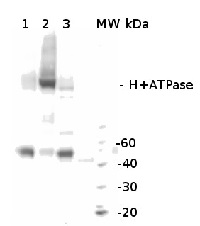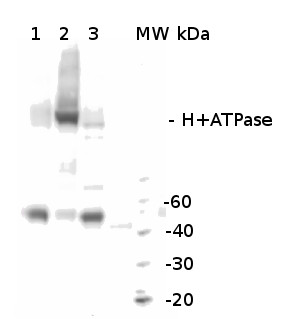1

Anti-H+ATPase | Plasma membrane H+ATPase (chicken antibody)
Benefits of using this antibody
- Product Info
-
Immunogen: KLH-conjugated synthetic peptide derived from available di and monocot, fern, mosses and algal plasma membrane ATPase sequences including Arabidopsis thaliana ATPase 1 (At2g18960) and ATPase 2,3,4,6,7,8,9 of Arabidopsis thaliana and hydrogen ATPase of Chlamydomonas reinhardtii (Q9FNS3)
Host: Chicken Clonality: Polyclonal Purity: Immunogen affinity purified IgY in PBS pH 7.4. Format: Lyophilized Quantity: 50 µg Reconstitution: For reconstitution add 50 µl of sterile water Storage: Store lyophilized/reconstituted at -20°C; once reconstituted make aliquots to avoid repeated freeze-thaw cycles. Please remember to spin the tubes briefly prior to opening them to avoid any losses that might occur from material adhering to the cap or sides of the tube. Tested applications: Western blot (WB) Recommended dilution: 1 : 1000-1 : 5000 (WB) Expected | apparent MW: 95 kDa (Arabidopsis thaliana)
- Reactivity
-
Confirmed reactivity: Arabidopsis thaliana, Spinacia oleracea, Zea mays Predicted reactivity: Angomonas deanei, Avena sativa, Brassica napus, Citrus limon, Coffea canephora, Cucumis sativus, Cucurbita moschata, Dunaliella spp, Eichhornia crassipes, Emiliana huxleyi, Glycine max (weak), Hordeum vulgare, Lactobacillus johnsonii, Laishamania braziliensis, Nicotiana tabacum, Oryza sativa, Solanum lycopersicon, Solanum tuberosum, Medicago truncatula, Mesembruanthemum crystallinum), Nannochloropsis gaditana CCMP526, Nepenthes alata, Nicotiana tabaccum, Nitrospira bacterium, Oryza sativa, Ostreococcus spp., Phaseolus acutifolius, Physocomitrella patens, Picea abies, Pinus thunbergii, Populus tremula, Pteris vittata, Ricinus communis, Saccharomyces cerevisiae, Solanum lycopersicum, Strigomonas culicis, Toxoplasma gondii, Triticum urartu, Trypanosoma cruzi, Zosteria marina, Vicia faba, Vigna angularis
Species of your interest not listed? Contact us - Application Examples
-
application example

10 µg of total protein from whole leaf extracts of Arabidopsis thaliana (1), Zea mays (2), Spinacia oleracea (3), extracted with Protein Extration Buffer, PEB (AS08 300), were boiled for 10 min. in 70°C and separated on 4-12% NuPage (Invitrogen) LDS-PAGE and blotted 1h to PVDF. Blots were blocked immediately following transfer in 2% ECL blocking reagent (GE Healthcare) in 20 mM Tris, 137 mM sodium chloride pH 7.6 with 0.1% (v/v) Tween-20 (TBS-T) for 1h at room temperature with agitation. Blots were incubated in the primary antibody at a dilution of 1: 2 500 for 1h at room temperature with agitation. The antibody solution was decanted and the blot was rinsed briefly twice, then washed once for 15 min and 3 times for 5 min in TBS-T at room temperature with agitation. Blots were incubated in secondary antibody (anti-rabbit IgG horse radish peroxidase conjugated, recommended secondary antibody AS10 1489) diluted to 1:25 000 for 1h at room temperature with agitation. The blots were washed as above and developed for 5 minutes according the manufacturers instructions. Images of the blots were obtained using a CCD imager (FluorSMax, Bio-Rad) and Quantity One software (Bio-Rad).
- Additional Information
-
Additional information: Cellular [compartment marker] for plasma membranetissue specific immunolocalization was done on paraffin emdedded samples as described here Additional information (application): VERY IMPORTANT: please, do not heat up your samples over 70°C as this might cause H+ATPase to precipitate and there will be no signal on your western blot - Background
-
Background: The Plasma Membrane H+ATPase is a family of proteins of ca. 100 kDa that are believed to be exclusive to the plasma membranes of plants and fungi. The protein is anchored within biological membrane which creates an electrochemical gradient used as an energy source and is essential for uptake of most metabolites and plant responses to environment, for example movement of leaves.
- Product Citations
-
Selected references: Cao et al. (2025).Ca2+-dependent cytoplasmic and nuclear phosphorylation of STOP1 by CPK21 and CPK23 confers ALMT1-dependent aluminum resistance. Nat Commun. 2025 Jun 5;16(1):5225. - Reviews:
-
This product doesn't have any reviews.
Accessories

AS07 260 | Clonality: Polyclonal | Host: Rabbit | Reactivity: [global antibody] for di- and monocots, conifers, ferns, mosses, green algae | Cellular [compartment marker] for plasma membrane
Benefits of using this antibody

AS07 213 | Clonality: Polyclonal | Host: Rabbit | Reactivity: Higher plants including A.comosus, A.thaliana, C.sativus, C. australis R.Br, C.reinhardtii, F. margarita Swingle, H.vulgare, L.esculentum, L.longiflorum, Malus x domestica Borkh. c.v. Fuji, M. truncatula, M.crystallinum, N.tabacum, N.caerulescens, O.sativa, P.hybrida cv. Mitchell, Populus sp., P.vittata, Thellungiella sp., T. aestivum, Z.mays, V. vinifera | Cellular [compartment marker] of tonoplast membrane

